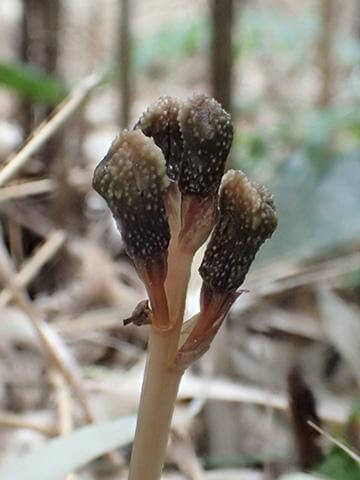Project Associate Professor Kenji Suetsugu (Kobe University Graduate School of Science) has discovered a new species of plant on the subtropical Japanese island of Kuroshima (located off the southern coast of Kyushu in Kagoshima prefecture) and named it Gastrodia kuroshimensis. This research was published on October 14 in the Phytotaxa.
Non-photosynthetic mycorrhizal plants, or mycoheterotrophic plants, have long attracted the curiosity of botanists and mycologists. However, a common feature of most mycoheterotrophic plants is their extreme scarcity and small size. In addition, most species are found in the dark understory of forests, only discoverable during the flowering and fruiting period when aboveground organs appear through the leaf litter. As such, we still have scant knowledge on the precise taxonomy of the mycoheterotrophic group.
Professor Suetsugu is involved in documenting the distribution and classification of mycoheterotrophic plants in Japan. In April 2016, during his research trip in the lowland forests in Kuroshima, he came across approximately one hundred individuals of an unfamiliar mycoheterotrophic species. He collected a specimen, carried out a detailed examination of the plant’s morphological characteristics and found that it was indeed a new species.
The description of a new flowering plant species in Japan is itself a very rare event as the flora of this region have been thoroughly investigated. However, G. kuroshimensis was a particularly special discovery because it is both completely mycoheterophic, deriving its nutrition not from photosynthesis but from host fungi, and completely cleistogamous, producing flowers that never bloom.
 Cleistogamy, literally meaning ‘a closed marriage’, refers to plants that produce flowers in which self-fertilization occurs within closed buds. This mechanism of reproduction has intrigued botanists since the time of Darwin, and is now recognized as an important mechanism of self-pollination that is found in a diverse range of plant taxa. However, most cleistogamous species also produce chasmogamous (cross-pollinating) flowers. Cleistogamous flowers are considered a bet-hedging strategy, since they require less resources than chasmogamous flowers, and because they can provide reproductive assurance by setting seeds in the absence of pollinators and under disadvantageous environmental conditions. In addition, cleistogamous flowers can also promote adaptation to local habitats, as both maternal sets of genes can be passed onto the progeny, purging deleterious alleles (gene variants which are generally harmful). However, this is a somewhat risky strategy as the progeny are also less able to adapt to changes in spatially and temporally heterogeneous habitats.
Cleistogamy, literally meaning ‘a closed marriage’, refers to plants that produce flowers in which self-fertilization occurs within closed buds. This mechanism of reproduction has intrigued botanists since the time of Darwin, and is now recognized as an important mechanism of self-pollination that is found in a diverse range of plant taxa. However, most cleistogamous species also produce chasmogamous (cross-pollinating) flowers. Cleistogamous flowers are considered a bet-hedging strategy, since they require less resources than chasmogamous flowers, and because they can provide reproductive assurance by setting seeds in the absence of pollinators and under disadvantageous environmental conditions. In addition, cleistogamous flowers can also promote adaptation to local habitats, as both maternal sets of genes can be passed onto the progeny, purging deleterious alleles (gene variants which are generally harmful). However, this is a somewhat risky strategy as the progeny are also less able to adapt to changes in spatially and temporally heterogeneous habitats.
The evolution of complete cleistogamy is therefore somewhat of a mystery. Chasmogamous flowers are an important factor in the success of most plants as even a small degree of outcrossing can result in a relatively rapid decline in linkage disequilibrium across the genome, and is sufficient to overcome the negative effects associated with an absence of effective recombination, such as the accumulation of deleterious mutations and a slowdown in the rate of adaptation. The discovery of G. kuroshimensis, therefore, provides a useful opportunity to further investigate the ecological significance, evolutionary history, and genetic mechanisms underlying the evolution of complete cleistogamy.
If our reporting has informed or inspired you, please consider making a donation. Every contribution, no matter the size, empowers us to continue delivering accurate, engaging, and trustworthy science and medical news. Independent journalism requires time, effort, and resources—your support ensures we can keep uncovering the stories that matter most to you.
Join us in making knowledge accessible and impactful. Thank you for standing with us!

